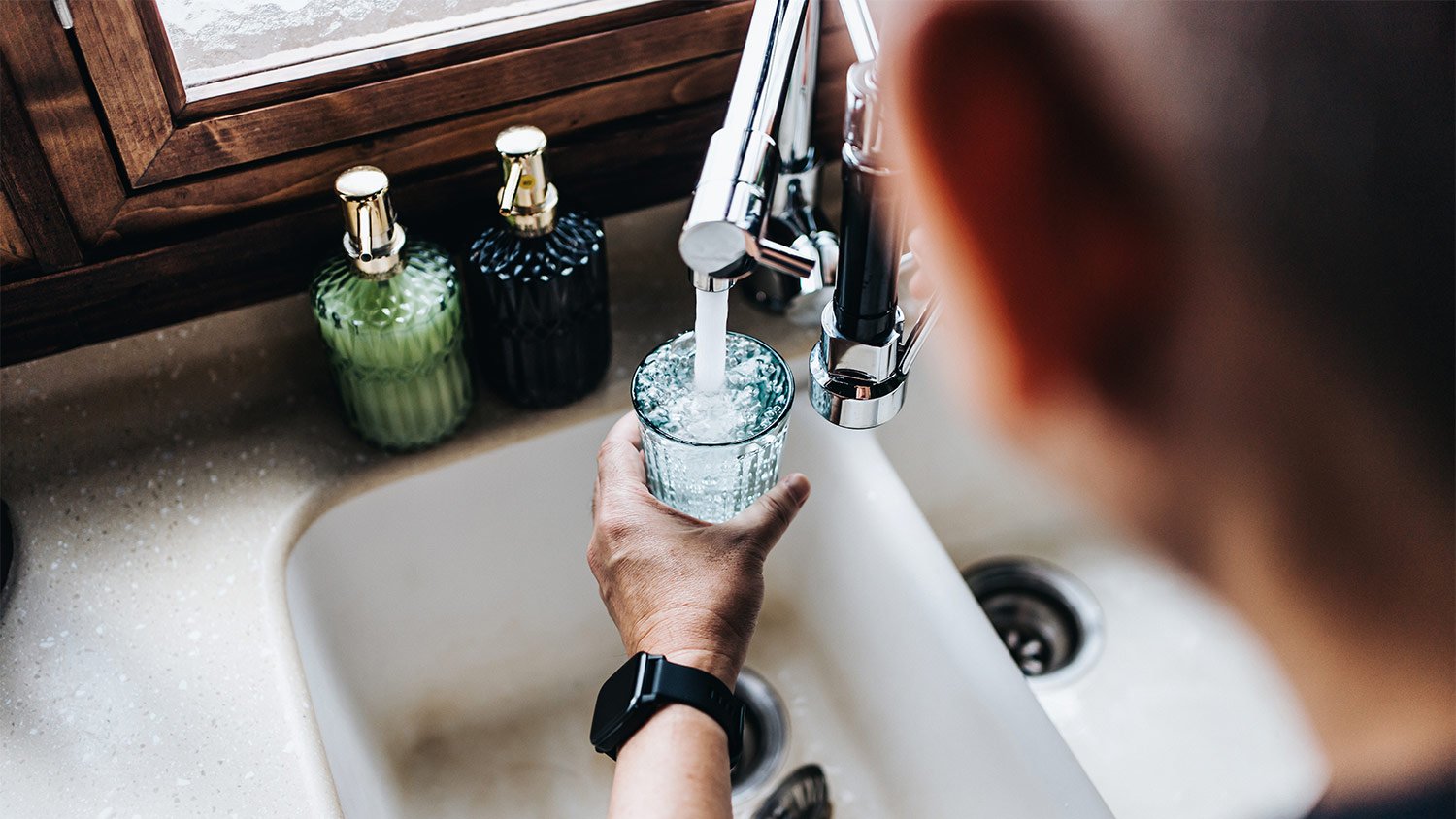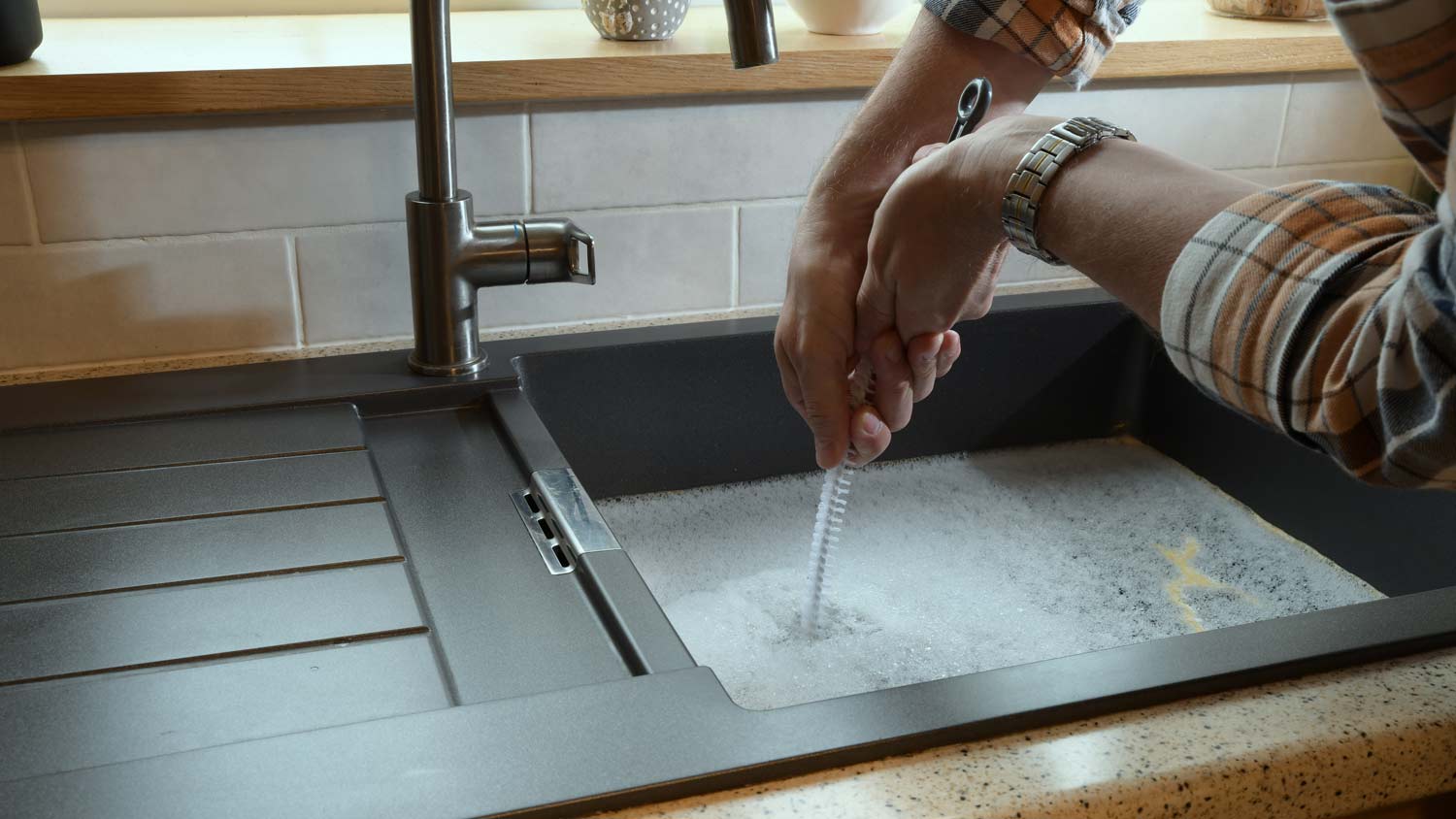How to Clean a Sink Drain Without Turning to Chemicals
Don’t worry: This cleaning task isn’t draining at all


- Large pot
- Plunger (optional)
- Drain snake (optional)
- Baking soda
- White vinegar
- Water
- Ice cubes
- Lemons
We’ve all been there: foul odors coming from the sink, slow-draining water (or water that won’t drain at all), weird gurgling sounds, or even a horde of drain flies in the kitchen or bathroom. It’s tempting to reach for the affordable chemical drain cleaner at the grocery store, but this can be bad for your plumbing and hazardous to you and the environment. So how do you clean a sink drain on your own?
We’ll walk you through a few easy steps to clean your drain (and even your garbage disposal) and also help you keep your sink drain clean going forward.
Pour Baking Soda and Vinegar Down the Drain
To clean your sink drain without a chemical cleaner, you’ll need to make a cleaning solution of your own. We’re going to use a 1:2 ratio of baking soda and white vinegar.
Start by pouring ½ cup of baking soda into the drain. Then measure out a cup of white vinegar and slowly pour it into the drain as well.
Together, the baking soda and vinegar will have a chemical reaction and start to fizz. Let the mixture do its thing for about 15 minutes.
Pro Tip: While you’re waiting, you can start boiling the water for step 2 and slicing the lemons that you’ll use in step 5.
Pour Boiling Water Down the Drain
 Photo: Maksim Luzgin / iStock / Getty Images Plus / Getty Images
Photo: Maksim Luzgin / iStock / Getty Images Plus / Getty ImagesAfter 15 minutes, rinse the drain with a pot of boiling water. Pour it slowly so you don’t get splashed with scalding hot water.
Repeat for Particularly Dirty Drains
If the drain is particularly dirty (like if it smells really bad or is draining super slowly), you may want to repeat steps 1 and 2. You can also do those two steps regularly to keep your drain clean.
Use a Plunger or Drain Snake, If Necessary
To unclog a drain that is giving you extra trouble, you can use a plunger — a sink plunger, ideally, but a yet-unused toilet plunger can also do the trick. Fill the sink with a little bit of water, then cover the drain with the plunger. Pump several times; the water should begin to drain.
If you use a plunger, we recommend cleaning the sink again with steps 1 and 2.
You may also use a drain snake to clear out hair and other debris from the drain. You can purchase these online or in hardware stores; just follow the instructions on the product.
If you’re not confident using a drain snake, consider hiring a plumber to unclog your drain.
A plumber may also be necessary if you need to physically remove the sink drain to take care of the clog, but savvy DIYers with the right tool might be able to do this themselves. Think you’re up for the task? Here’s how to remove a sink drain to tackle a particularly tough clog.
Clean the Garbage Disposal
 Photo: Liudmila Chernetska / iStock / Getty Images Plus / Getty Images
Photo: Liudmila Chernetska / iStock / Getty Images Plus / Getty ImagesOnce you’re satisfied that the drain is clean, you can move onto the garbage disposal if your kitchen sink has one. (You can obviously skip this step if you’re cleaning a bathroom or laundry sink drain.)
To clean the garbage disposal, place a few lemon slices, some ice cubes, and a few pinches of coarse salt inside the sink drain. Then turn on the garbage disposal while running the cold water tap. The salt will help to scrub the blades, the ice is great for removing grime, and the lemon adds a fresh scent.
Regularly cleaning your garbage disposal is a good idea, but you may need to give it some extra love if it’s clogged. Here’s how to unclog a garbage disposal.
A Note on Chemical Drain Cleaners
In most cases, plumbers advise against using chemical drain cleaners, especially if your home has older drain pipes. Chemical drain cleaners could be OK to use for newer, plastic pipes—but even then, it should be a last resort. These cleaners can be damaging to your pipes, harmful to your skin if you come into contact with them, and bad for the environment. In addition, chemical drain cleaners usually only provide a temporary solution.
If you hire a plumber for a job related to your sink drain, you can ask their opinion on using chemical cleaners in the future; they’ll be able to speak to the pros and cons of liquid drain cleaners. But if you keep up with regular drain cleaning using baking soda and vinegar, you shouldn’t find yourself with clogged drains as often anyway.
How to Keep Your Sink Drain Clean
Now you know how to clean your sink drain, but with a few preventative measures, you can keep it from getting dirty or clogged to begin with. Here are a few ways to keep it clean going forward:
Pour bleach down the drain: Once every week, right before bedtime, pour some bleach down the drain and let it sit overnight. This will kill any bacteria and flies. Just rinse the drain with water in the morning.
Routinely dump boiling water down the drain: Do this once or twice a week, particularly after doing dishes.
Actively protect your drain: Never pour grease or coffee grounds down the kitchen sink drain, and use a mesh screen over the bathroom sink drain to keep hair from washing down it. When shaving your face, you can place a towel over the sink, then shake the towel out outside and wash it with your laundry.
Don’t overdo it on the garbage disposal: If you can, compost uneaten food items (just make sure they’re compostable!) or throw out big scraps. Only rely on your garbage disposal for small bits of food on plates and in bowls when doing the dishes.
DIY vs. Hiring a Pro
Once you know how to clean a sink drain on your own, there’s almost never a reason to call in a pro. Just make sure you use our process instead of chemical drain cleaners.
If you’re fighting a particularly tough clog that you can’t get by yourself, call a trusted plumber near you. The job should take less than an hour; most plumbers cost between $100 and $200 for such a simple service call.
Frequently Asked Questions
Baking soda and vinegar is a great solution for cleaning your sink drain; in fact, it’s our preferred method. Here’s how to unclog your drain with baking soda and vinegar: Pour in a half cup of baking soda, then 1 cup of white vinegar, and let the two bubble for 15 minutes. Then rinse out with boiling water. This method is much safer than using a chemical drain cleaner gel.
To clean gunk out of a sink drain, pour in a half cup of baking soda, then 1 cup of white vinegar. The two will react chemically; let them fizz for 15 minutes, then rinse with boiling water. Repeat these steps if necessary for particularly dirty sink drains, and consider a drain snake if there are clogs.















